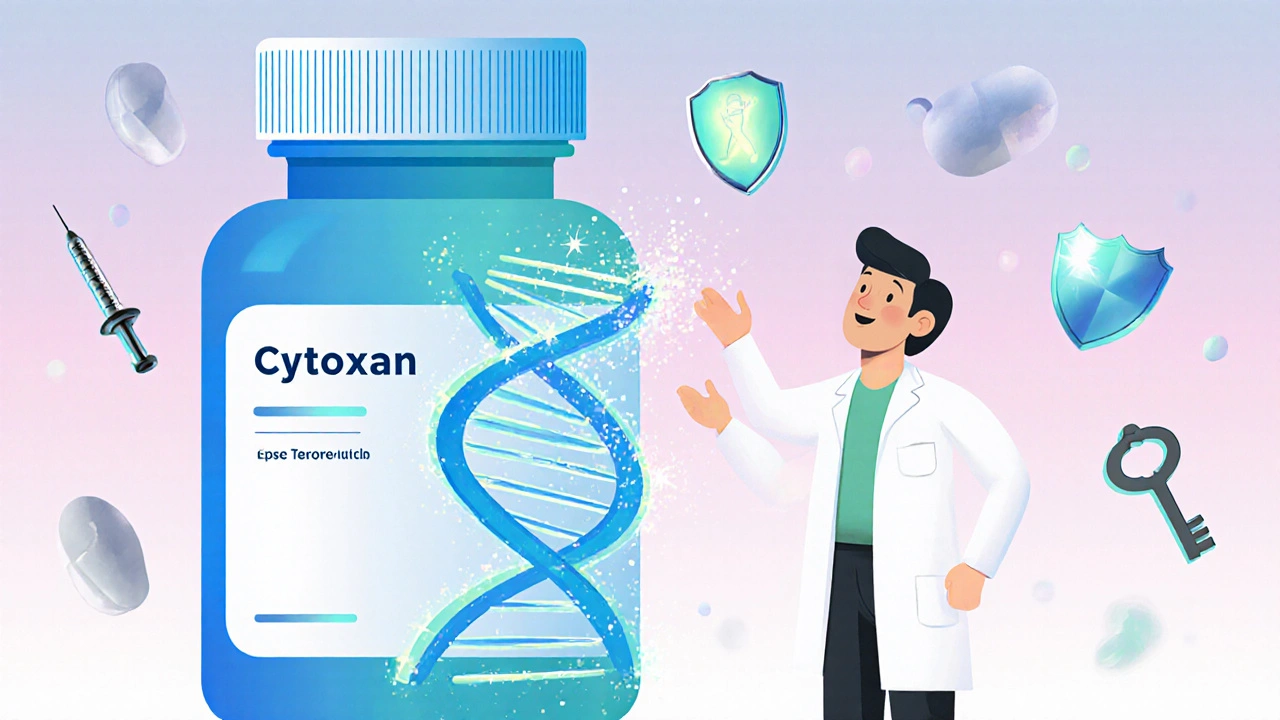Chemotherapy Side Effect Comparison Tool
Side Effect Comparison Tool
Select one or more side effect concerns to see which chemotherapy drugs pose the greatest risk. This tool helps compare Cytoxan with other common chemotherapy agents based on your specific concerns.
Relevant Chemotherapy Options
When doctors talk about chemotherapy, Cytoxan (Cyclophosphamide) is one of the first names that comes up. It’s been a workhorse in oncology for decades, but the drug landscape has expanded a lot. New agents, different mechanisms, and varying side‑effect profiles mean patients and clinicians often wonder how Cytoxan stacks up against the options on the table. This guide walks you through the basics, compares the major alternatives, and helps you see which drug might fit a specific cancer or situation best.
Key Takeaways
- Cytoxan is an alkylating agent that works by damaging DNA in rapidly dividing cells.
- Common alternatives include Methotrexate, Doxorubicin, Ifosfamide, Rituximab and newer immunotherapies like Pembrolizumab.
- Side‑effect profiles vary: Cytoxan causes myelosuppression and bladder irritation, while agents such as Doxorubicin carry a risk of heart damage.
- Cost and administration routes differ - oral Cytoxan is cheap, whereas monoclonal antibodies are expensive and given IV.
- Choosing the right drug depends on cancer type, patient health, and treatment goals.
What Is Cytoxan (Cyclophosphamide) and How Does It Work?
Cytoxan is the brand name for cyclophosphamide, an alkylating chemotherapy agent first approved in the 1950s. It belongs to the nitrogen mustard class and works by adding an alkyl group to the DNA strands of cancer cells. This prevents the cells from replicating and ultimately triggers cell death.
The drug is a pro‑drug; it needs activation in the liver where it turns into phosphoramide mustard, the actual DNA‑damaging component. Because the activation step is systemic, Cytoxan reaches both primary tumors and hidden metastases, making it useful for a wide range of solid tumors and blood cancers.
Typical Clinical Uses of Cytoxan
Doctors prescribe Cytoxan for several cancers, including:
- Breast cancer (especially in combination regimens)
- Non‑Hodgkin lymphoma
- Chronic lymphocytic leukemia
- Multiple myeloma
- Some cases of ovarian cancer and soft‑tissue sarcoma
Beyond oncology, low‑dose Cytoxan is sometimes used to suppress autoimmune disorders like systemic lupus erythematosus because its immunosuppressive effect calms an overactive immune system.

Major Alternatives to Cytoxan
While Cytoxan remains popular, several other agents can be better choices depending on the disease and patient profile.
Methotrexate
Methotrexate is a folate antagonist that blocks the enzyme dihydrofolate reductase, halting DNA synthesis. It’s commonly used for breast cancer, osteosarcoma, and certain leukemias. Unlike Cytoxan, which is given orally or intravenously, methotrexate often requires high‑dose IV infusion and rigorous folic‑acid rescue to limit toxicity.
Doxorubicin
Doxorubicin belongs to the anthracycline class. It intercalates DNA and generates free radicals that break DNA strands. It’s a staple for breast cancer, lymphoma, and soft‑tissue sarcoma. The biggest downside is cumulative cardiac toxicity, which limits the total lifetime dose.
Ifosfamide
Ifosfamide is a sister compound to cyclophosphamide, sharing the same alkylating core but with a different activation pathway. It’s often paired with mesna to protect the bladder. Ifosfamide tends to be chosen for testicular cancer and certain sarcomas where Cytoxan alone is insufficient.
Rituximab
Rituximab is a monoclonal antibody that targets CD20 on B‑cell lymphomas. Instead of damaging DNA, it flags cancerous B cells for destruction by the immune system. It’s a go‑to for non‑Hodgkin lymphoma and chronic lymphocytic leukemia, often combined with chemotherapy (e.g., R‑CHOP).
Pembrolizumab
Pembrolizumab is an immune checkpoint inhibitor that blocks PD‑1, unleashing T‑cells to attack tumors. It’s not a direct replacement for Cytoxan but is an alternative for cancers that express PD‑L1, such as certain lung and melanoma cases. The side‑effect profile focuses on immune‑related inflammation rather than bone‑marrow suppression.
Side‑Effect Profile Comparison
Understanding how each drug impacts the body helps weigh risks versus benefits. Below is a quick snapshot of the most common toxicities.
| Drug | Primary Toxicity | Secondary Concerns | Management Strategies |
|---|---|---|---|
| Cytoxan | Myelosuppression (low blood counts) | Hemorrhagic cystitis, nausea | Mesna for bladder protection, growth‑factor support |
| Methotrexate | Myelosuppression | Mucositis, hepatic toxicity, renal insufficiency | Leucovorin rescue, hydration, dose adjustment |
| Doxorubicin | Cardiotoxicity (dose‑dependent) | Myelosuppression, alopecia | Cardiac monitoring, limit cumulative dose |
| Ifosfamide | Myelosuppression | Neurotoxicity, hemorrhagic cystitis | Mesna, adequate hydration, neurological monitoring |
| Rituximab | Infusion‑related reactions | Infections, hepatitis B reactivation | Premedication, viral screening |
| Pembrolizumab | Immune‑related adverse events | Colitis, pneumonitis, endocrinopathies | Corticosteroids, specialist referral |
Cost and Administration Considerations
Cost often nudges the choice. Oral Cytoxan is inexpensive-usually under $20 per month in many markets-while intravenous methotrexate or doxorubicin can run several hundred dollars per cycle. Monoclonal antibodies like rituximab and checkpoint inhibitors such as pembrolizumab are premium therapies, often exceeding $5,000 per dose.
Administration route matters too. Cytoxan can be taken at home as a pill, making it convenient for long‑term maintenance. Most alternatives need infusion centers, which adds travel time, nursing fees, and monitoring requirements.
How to Choose the Right Agent for a Specific Cancer
Here’s a quick decision framework you can run through with a clinician:
- Identify the cancer type and stage. Certain drugs have proven superiority for specific histologies (e.g., rituximab for CD20‑positive lymphomas).
- Assess patient health. Heart disease steers you away from doxorubicin; pre‑existing bladder issues make cyclophosphamide less attractive without aggressive mesna prophylaxis.
- Review prior treatments. If a tumor has become resistant to alkylating agents, switching to a different class like antimetabolites or immunotherapy may yield better response.
- Consider side‑effect tolerance. Some patients cannot handle severe nausea, while others may prioritize preserving fertility over convenience.
- Factor in cost and logistics. Insurance coverage, travel distance to infusion centers, and out‑of‑pocket expenses can tip the scales.
Remember, the best drug is the one that aligns with the disease biology **and** the patient’s life goals.
Frequently Asked Questions
Can Cytoxan be used alone for breast cancer?
Yes, Cytoxan can be part of a single‑agent regimen, especially in the adjuvant setting, but it’s often combined with taxanes or anthracyclines to improve response rates.
What makes Ifosfamide different from Cyclophosphamide?
Both are alkylating agents, but Ifosfamide generates more neurotoxic metabolites and is usually paired with mesna to protect the bladder. It’s preferred for testicular cancer and some sarcomas where higher dose intensity is needed.
Why do some patients receive rituximab instead of Cytoxan?
Rituximab targets CD20 on B‑cells, offering a mechanism that doesn’t rely on DNA damage. For CD20‑positive lymphomas, adding rituximab improves survival and reduces the need for high‑dose alkylators, which can be harsher on the bone marrow.
Is there a risk of infertility with Cytoxan?
High‑dose cyclophosphamide can harm sperm production in men and ovarian reserve in women. Fertility preservation (sperm banking, oocyte freezing) is recommended before starting treatment when a high cumulative dose is planned.
How is bladder toxicity prevented when using Cytoxan?
Patients are given mesna, a sulfhydryl donor that binds to toxic metabolites in the urinary tract, and are advised to stay well‑hydrated. Regular urinalysis monitors for early signs of irritation.


erica fenty
Cytoxan’s alkylating mechanism, targeting rapidly dividing DNA, offers broad‑spectrum activity; however, its myelosuppressive profile mandates vigilant blood count monitoring, especially in combo regimens.
Oral bioavailability reduces infusion‑center burden, which can be a decisive factor for patient adherence.
Consider concurrent mesna prophylaxis to mitigate hemorrhagic cystitis-a standard of care in high‑dose cycles.
Esther Olabisi
Sure, nothing says “fun” like juggling mesna and blood draws 😂.
Ivan Laney
The evolution of chemotherapy from the crude nitrogen mustards to the sophisticated checkpoint inhibitors reflects not only scientific ingenuity but also the geopolitical ambition of nations to dominate the lucrative pharmaceutical market, a fact often glossed over in clinical lectures.
When evaluating Cytoxan against agents like doxorubicin or pembrolizumab, one must weigh not only the pharmacodynamic nuances-such as DNA cross‑linking versus immune checkpoint blockade-but also the underlying economic incentives that drive drug development pipelines in the West versus the emerging markets.
Moreover, the cardiotoxic ceiling of anthracyclines imposes a hidden cost on healthcare systems that cannot absorb long‑term cardiac care, whereas the bladder toxicity of cyclophosphamide, though preventable with mesna, still incurs ancillary expenses that are frequently underreported in trial disclosures.
Therefore, a decision matrix that incorporates efficacy, toxicity, and fiscal impact must be calibrated to the patient’s socioeconomic context, lest we inadvertently prioritize profit over patient‑centered outcomes.
In practice, this means a multidisciplinary team should convene, including oncologists, pharmacists, and financial counselors, to tailor the regimen to each individual’s clinical and fiscal realities.
Jasmina Redzepovic
While your macro‑analysis captures market dynamics, the micro‑pharmacologic distinction remains pivotal: cyclophosphamide’s activation via hepatic cytochrome P450 generates phosphoramide mustard, a bifunctional alkylating moiety that induces interstrand DNA cross‑links, contrasting sharply with pembrolizumab’s PD‑1 blockade which elicits T‑cell effector functions without direct genotoxicity.
Jake Hayes
Cardiotoxicity limits doxorubicin dosing; cyclophosphamide spares the heart but demands mesna.
Angela Koulouris
Think of Cytoxan as the reliable workhorse in your oncology stable-it may not sparkle like a monoclonal antibody, but it consistently pulls the load when you pair it with the right teammates.
Harry Bhullar
Cytoxan has been a cornerstone of chemotherapy regimens for over half a century, and its longevity speaks to both efficacy and adaptability.
Its mechanism as an alkylating agent allows it to target a broad range of malignancies, from breast cancer to lymphomas.
One of the main advantages is oral administration, which reduces the need for frequent hospital visits.
Patients on low‑dose cyclophosphamide often experience manageable nausea with standard antiemetics.
However, the drug’s myelosuppressive effects require regular CBC monitoring to catch neutropenia early.
Bladder toxicity, manifested as hemorrhagic cystitis, can be effectively prevented with mesna and aggressive hydration.
When combining Cytoxan with other agents, dose adjustments may be necessary to avoid overlapping toxicities.
Cost considerations are significant; generic cyclophosphamide is inexpensive compared to biologics like rituximab or pembrolizumab.
In resource‑limited settings, this affordability makes Cytoxan an attractive option for curative intent therapy.
Nonetheless, clinicians must weigh the risk of infertility, especially in young patients receiving high cumulative doses.
Fertility preservation strategies such as sperm banking or oocyte cryopreservation should be discussed upfront.
For elderly patients with comorbidities, the oral route may improve quality of life by minimizing infusional side effects.
Therapeutic response rates can be enhanced when Cytoxan is part of combination protocols, such as R‑CHOP for non‑Hodgkin lymphoma.
Clinical guidelines often recommend monitoring liver function tests due to rare hepatic toxicity.
Overall, Cytoxan remains a versatile, cost‑effective backbone of many chemotherapy regimens, provided its toxicities are proactively managed.
Dana Yonce
Taking Cytoxan at home is doable with proper hydration and mesna prophylaxis 😊.
Lolita Gaela
In practice, you’ll see cyclophosphamide dosed at 500‑600 mg/m² IV on day 1 of a 21‑day cycle, or at 100 mg oral daily for maintenance, with dose modifications guided by ANC thresholds per CTCAE v5.0.
Xavier Lusky
Many patients don’t realize that the push for newer, expensive immunotherapies is driven by pharmaceutical lobbying that sidelines affordable, generic options like cyclophosphamide.
Ashok Kumar
Oh sure, let’s throw a $10,000 checkpoint inhibitor at every tumor while ignoring a $20 pill that works just as well for many indications – brilliant strategy.